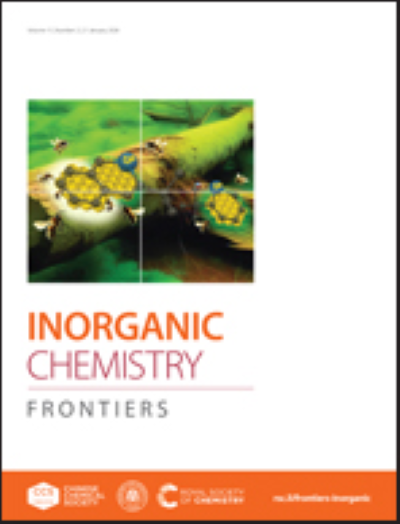Exploring Copper β-Diketiminate Complexes for Heterogeneous Ammonia Oxidation Anchored on Graphitic Surfaces via CH-π and π-π Interactions
IF 6.1
1区 化学
Q1 CHEMISTRY, INORGANIC & NUCLEAR
引用次数: 0
Abstract
Ammonia is a compelling candidate for a carbon-free energy carrier, offering potential applications as both a hydrogen vector and a fuel. Unlocking these applications requires the development of efficient ammonia oxidation catalysts. Building on recent work with a fluorinated Cu(I) β-diketiminate catalyst for homogeneous ammonia oxidation, we present the first examples of hybrid electrodes employing first-row metal complexes and supramolecular anchoring for heterogeneous ammonia oxidation. In this study, we developed innovative synthetic methodologies to produce a family of β-diketiminate ligands and complexes. Some analogues clarified the role of each functional group in the original ligand, while others incorporated moieties designed to facilitate immobilization on graphitic surfaces via CH-π and π-π interactions. These structural modifications not only broadened the scope of ligand design but also advanced our understanding of their roles in catalysis and immobilization. Unexpectedly, all synthesized Cu complexes, including the previously reported catalyst, formed an equilibrium with [CuI(NH3)4]+ or [CuII(NH3)4]+ in the presence of ammonia, leading to ligand dissociation and subsequent catalyst deactivation. Despite these challenges, we demonstrated that anchoring these complexes is feasible and confirmed that heterogeneous ammonia oxidation is possible with this system. This work represents a pivotal step toward the construction of ammonia oxidation systems based on earth-abundant metals, highlighting the promise of Cu β-diketiminate complexes. Addressing the challenges of ligand loss and catalyst stability will pave the way for robust and efficient systems, driving advancements in sustainable ammonia-based energy technologies.通过CH-π和π-π相互作用探索铜β-二氯胺酸配合物在石墨表面的非均相氨氧化
氨是一种极具竞争力的无碳能源载体,既可以作为氢载体,也可以作为燃料。解锁这些应用需要开发高效的氨氧化催化剂。基于最近使用氟化Cu(I) β-二氯胺酸盐催化剂进行均相氨氧化的工作,我们提出了采用第一排金属配合物和超分子锚定的杂化电极用于非均相氨氧化的第一个例子。在这项研究中,我们开发了创新的合成方法来生产一个家族的β-二酮酸配体和配合物。一些类似物阐明了原始配体中每个官能团的作用,而其他类似物则通过CH-π和π-π相互作用加入了旨在促进石墨表面固定的部分。这些结构修饰不仅拓宽了配体设计的范围,而且提高了我们对配体在催化和固定化中的作用的理解。出乎意料的是,所有合成的Cu配合物,包括之前报道的催化剂,在氨存在下与[CuI(NH3)4]+或[CuII(NH3)4]+形成平衡,导致配体解离和随后的催化剂失活。尽管存在这些挑战,我们证明了锚定这些配合物是可行的,并证实了该系统可以进行多相氨氧化。这项工作代表了构建基于地球上丰富的金属的氨氧化系统的关键一步,突出了Cu β-二氯盐配合物的前景。解决配体损失和催化剂稳定性的挑战将为构建强大高效的系统铺平道路,推动可持续氨基能源技术的发展。
本文章由计算机程序翻译,如有差异,请以英文原文为准。
求助全文
约1分钟内获得全文
求助全文
来源期刊

Inorganic Chemistry Frontiers
CHEMISTRY, INORGANIC & NUCLEAR-
CiteScore
10.40
自引率
7.10%
发文量
587
审稿时长
1.2 months
期刊介绍:
The international, high quality journal for interdisciplinary research between inorganic chemistry and related subjects
 求助内容:
求助内容: 应助结果提醒方式:
应助结果提醒方式:


